window SATURN ION 2005 Owners Manual
[x] Cancel search | Manufacturer: SATURN, Model Year: 2005, Model line: ION, Model: SATURN ION 2005Pages: 366, PDF Size: 2.74 MB
Page 1 of 366
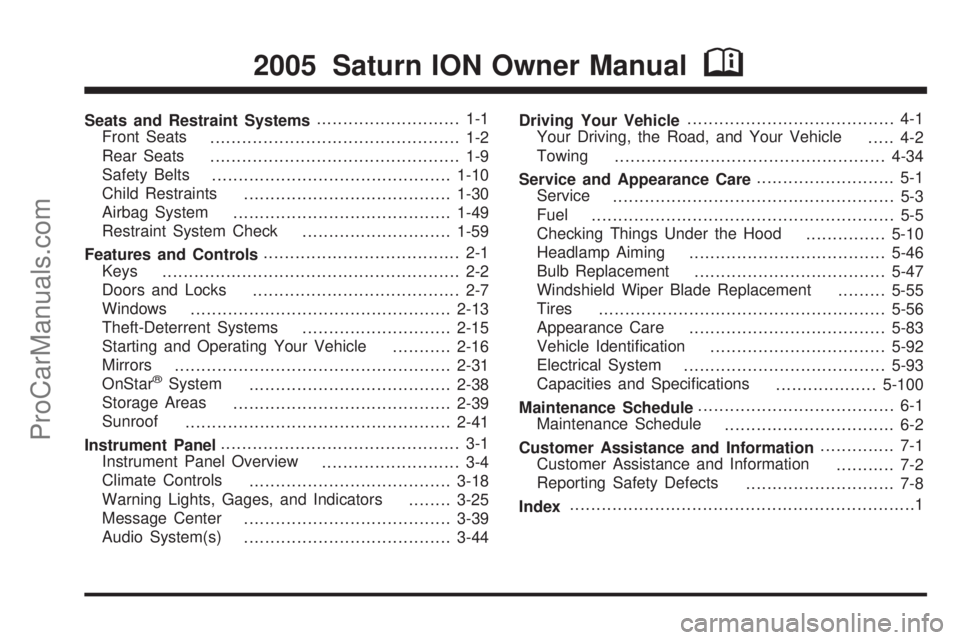
Seats and Restraint Systems........................... 1-1
Front Seats
............................................... 1-2
Rear Seats
............................................... 1-9
Safety Belts
.............................................1-10
Child Restraints
.......................................1-30
Airbag System
.........................................1-49
Restraint System Check
............................1-59
Features and Controls..................................... 2-1
Keys
........................................................ 2-2
Doors and Locks
....................................... 2-7
Windows
.................................................2-13
Theft-Deterrent Systems
............................2-15
Starting and Operating Your Vehicle
...........2-16
Mirrors
....................................................2-31
OnStar
®System
......................................2-38
Storage Areas
.........................................2-39
Sunroof
..................................................2-41
Instrument Panel............................................. 3-1
Instrument Panel Overview
.......................... 3-4
Climate Controls
......................................3-18
Warning Lights, Gages, and Indicators
........3-25
Message Center
.......................................3-39
Audio System(s)
.......................................3-44Driving Your Vehicle....................................... 4-1
Your Driving, the Road, and Your Vehicle
..... 4-2
Towing
...................................................4-34
Service and Appearance Care.......................... 5-1
Service
..................................................... 5-3
Fuel
......................................................... 5-5
Checking Things Under the Hood
...............5-10
Headlamp Aiming
.....................................5-46
Bulb Replacement
....................................5-47
Windshield Wiper Blade Replacement
.........5-55
Tires
......................................................5-56
Appearance Care
.....................................5-83
Vehicle Identi�cation
.................................5-92
Electrical System
......................................5-93
Capacities and Speci�cations
...................5-100
Maintenance Schedule..................................... 6-1
Maintenance Schedule
................................ 6-2
Customer Assistance and Information.............. 7-1
Customer Assistance and Information
........... 7-2
Reporting Safety Defects
............................ 7-8
Index.................................................................1
2005 Saturn ION Owner ManualM
ProCarManuals.com
Page 37 of 366
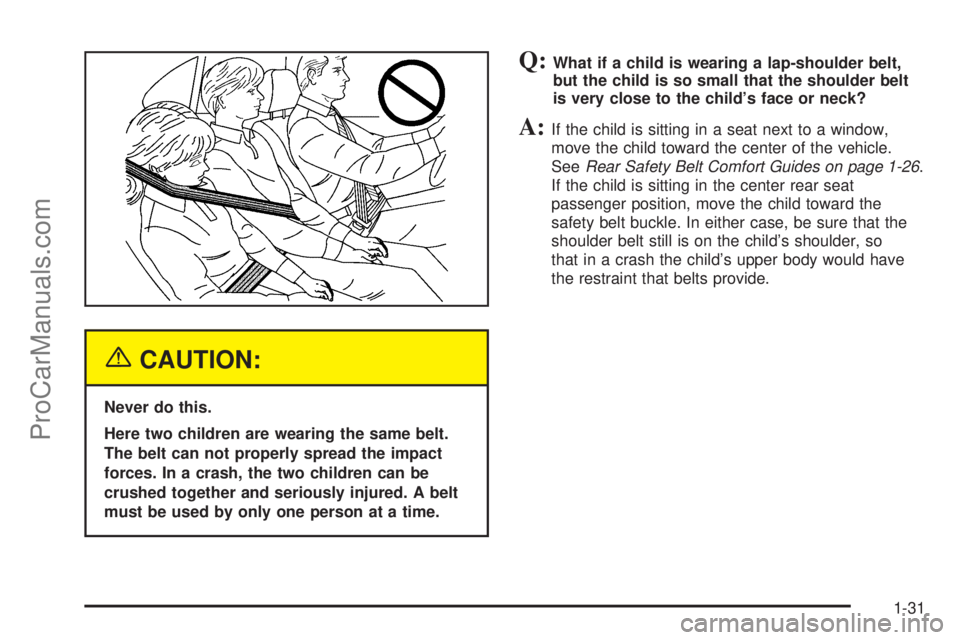
{CAUTION:
Never do this.
Here two children are wearing the same belt.
The belt can not properly spread the impact
forces. In a crash, the two children can be
crushed together and seriously injured. A belt
must be used by only one person at a time.
Q:What if a child is wearing a lap-shoulder belt,
but the child is so small that the shoulder belt
is very close to the child’s face or neck?
A:If the child is sitting in a seat next to a window,
move the child toward the center of the vehicle.
SeeRear Safety Belt Comfort Guides on page 1-26.
If the child is sitting in the center rear seat
passenger position, move the child toward the
safety belt buckle. In either case, be sure that the
shoulder belt still is on the child’s shoulder, so
that in a crash the child’s upper body would have
the restraint that belts provide.
1-31
ProCarManuals.com
Page 43 of 366

A forward-facing child seat (C-E) provides restraint for
the child’s body with the harness and also sometimes
with surfaces such as T-shaped or shelf-like shields.A booster seat (F-G) is a child restraint designed to
improve the �t of the vehicle’s safety belt system. Some
booster seats have a shoulder belt positioner, and
some high-back booster seats have a �ve-point harness.
A booster seat can also help a child to see out the
window.
1-37
ProCarManuals.com
Page 47 of 366

Top Strap Anchor Location
Your vehicle has top strap anchors in the rear seating
positions.
Do not secure a child restraint in the right front
passenger’s position if a national or local law requires
that the top strap be anchored, or if the instructions that
come with the child restraint say that the top strap
must be anchored. There is no place to anchor the top
strap in this position.
The sedan has three top strap anchors located on the
rear window trim.The coupe has two top strap anchors located behind
the rear seat on the �ller panel.
In order to access the anchors, you will have to open
the covers if the anchor has one.
Sedan
Coupe
1-41
ProCarManuals.com
Page 55 of 366

Airbag System
Your vehicle has a frontal airbag for the driver and a
frontal airbag for the right front passenger. Your vehicle
may also have roof-mounted side impact airbags.
Roof-mounted side impact airbags are available for the
driver and the passenger seated directly behind the
driver and for the right front passenger and the
passenger seated directly behind that passenger.
If your vehicle has side impact airbags, the words
AIR BAG will appear on the airbag covering on the ceiling
near the driver’s and right front passenger’s window.
Frontal airbags are designed to help reduce the risk of
injury from the force of an in�ating frontal airbag.
But these airbags must in�ate very quickly to do their
job and comply with federal regulations.
Here are the most important things to know about the
airbag system:
{CAUTION:
You can be severely injured or killed in a crash
if you are not wearing your safety belt — even
if you have airbags. Wearing your safety belt
CAUTION: (Continued)
CAUTION: (Continued)
during a crash helps reduce your chance of
hitting things inside the vehicle or being
ejected from it. Airbags are “supplemental
restraints” to the safety belts. All airbags are
designed to work with safety belts but do not
replace them.
Frontal airbags for the driver and right front
passenger are designed to deploy in moderate
to severe frontal and near frontal crashes.
They are not designed to in�ate in rollover,
rear or low-speed frontal crashes, or in many
side crashes. And, for some unrestrained
occupants, frontal airbags may provide less
protection in frontal crashes than more
forceful airbags have provided in the past.
Roof-mounted side impact airbags are designed
to in�ate in moderate to severe crashes where
something hits the side of your vehicle. They
are not designed to in�ate in frontal, in rollover
or in rear crashes. Everyone in your vehicle
should wear a safety belt properly — whether or
not there is an airbag for that person.
1-49
ProCarManuals.com
Page 58 of 366

The right front passenger’s frontal airbag is in the
instrument panel on the passenger’s side.If your vehicle has a side impact airbag for the driver
and the person seated directly behind the driver, it is in
the ceiling above the side windows.
1-52
ProCarManuals.com
Page 59 of 366
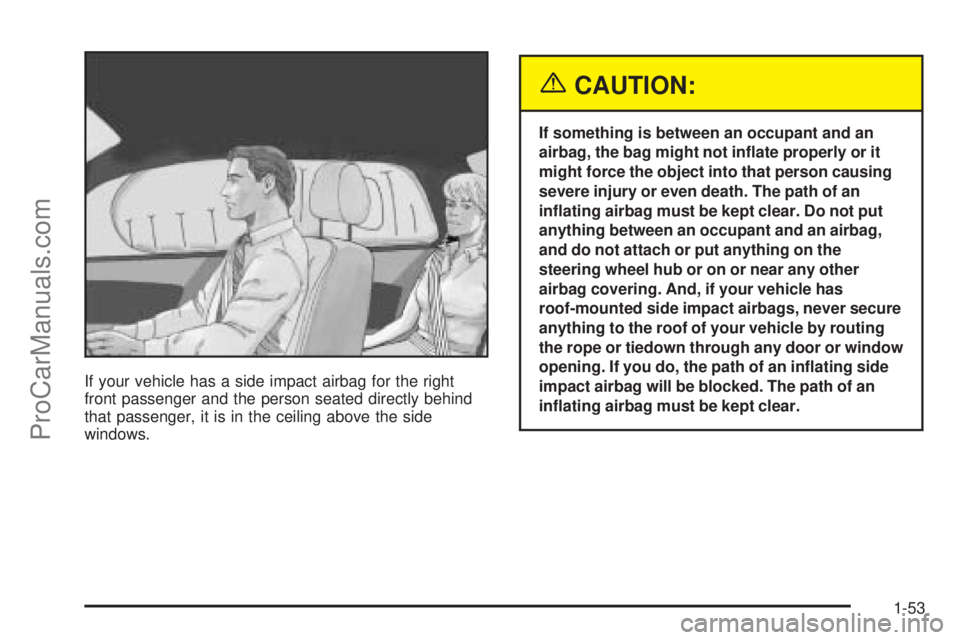
If your vehicle has a side impact airbag for the right
front passenger and the person seated directly behind
that passenger, it is in the ceiling above the side
windows.
{CAUTION:
If something is between an occupant and an
airbag, the bag might not in�ate properly or it
might force the object into that person causing
severe injury or even death. The path of an
in�ating airbag must be kept clear. Do not put
anything between an occupant and an airbag,
and do not attach or put anything on the
steering wheel hub or on or near any other
airbag covering. And, if your vehicle has
roof-mounted side impact airbags, never secure
anything to the roof of your vehicle by routing
the rope or tiedown through any door or window
opening. If you do, the path of an in�ating side
impact airbag will be blocked. The path of an
in�ating airbag must be kept clear.
1-53
ProCarManuals.com
Page 61 of 366
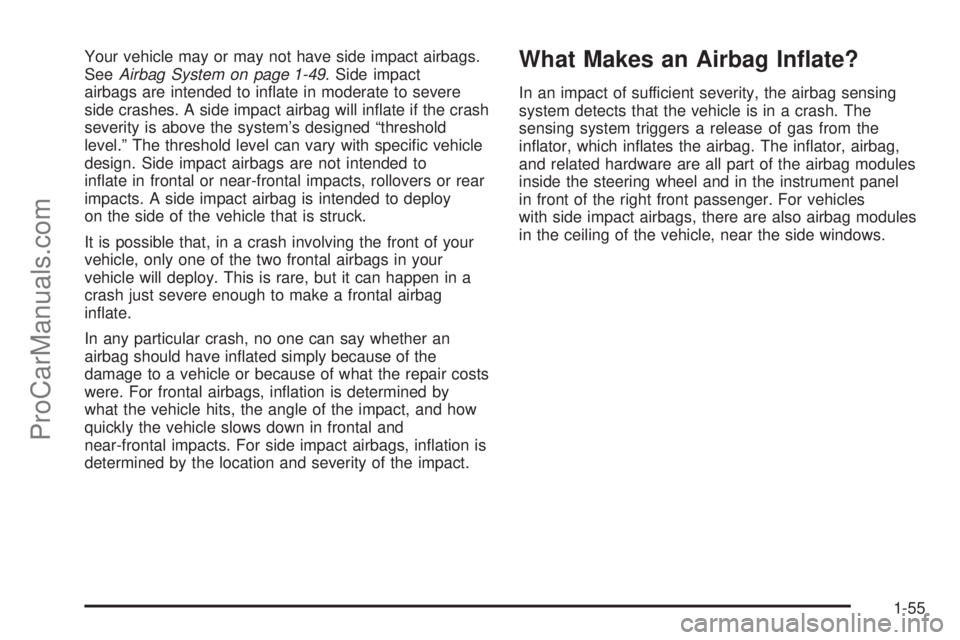
Your vehicle may or may not have side impact airbags.
SeeAirbag System on page 1-49. Side impact
airbags are intended to in�ate in moderate to severe
side crashes. A side impact airbag will in�ate if the crash
severity is above the system’s designed “threshold
level.” The threshold level can vary with speci�c vehicle
design. Side impact airbags are not intended to
in�ate in frontal or near-frontal impacts, rollovers or rear
impacts. A side impact airbag is intended to deploy
on the side of the vehicle that is struck.
It is possible that, in a crash involving the front of your
vehicle, only one of the two frontal airbags in your
vehicle will deploy. This is rare, but it can happen in a
crash just severe enough to make a frontal airbag
in�ate.
In any particular crash, no one can say whether an
airbag should have in�ated simply because of the
damage to a vehicle or because of what the repair costs
were. For frontal airbags, in�ation is determined by
what the vehicle hits, the angle of the impact, and how
quickly the vehicle slows down in frontal and
near-frontal impacts. For side impact airbags, in�ation is
determined by the location and severity of the impact.What Makes an Airbag In�ate?
In an impact of sufficient severity, the airbag sensing
system detects that the vehicle is in a crash. The
sensing system triggers a release of gas from the
in�ator, which in�ates the airbag. The in�ator, airbag,
and related hardware are all part of the airbag modules
inside the steering wheel and in the instrument panel
in front of the right front passenger. For vehicles
with side impact airbags, there are also airbag modules
in the ceiling of the vehicle, near the side windows.
1-55
ProCarManuals.com
Page 62 of 366
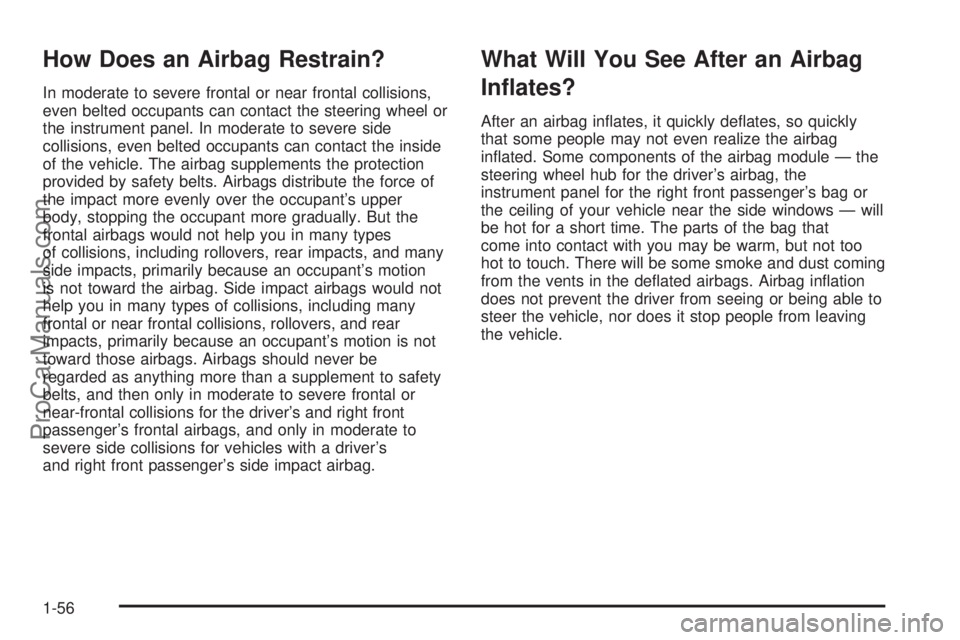
How Does an Airbag Restrain?
In moderate to severe frontal or near frontal collisions,
even belted occupants can contact the steering wheel or
the instrument panel. In moderate to severe side
collisions, even belted occupants can contact the inside
of the vehicle. The airbag supplements the protection
provided by safety belts. Airbags distribute the force of
the impact more evenly over the occupant’s upper
body, stopping the occupant more gradually. But the
frontal airbags would not help you in many types
of collisions, including rollovers, rear impacts, and many
side impacts, primarily because an occupant’s motion
is not toward the airbag. Side impact airbags would not
help you in many types of collisions, including many
frontal or near frontal collisions, rollovers, and rear
impacts, primarily because an occupant’s motion is not
toward those airbags. Airbags should never be
regarded as anything more than a supplement to safety
belts, and then only in moderate to severe frontal or
near-frontal collisions for the driver’s and right front
passenger’s frontal airbags, and only in moderate to
severe side collisions for vehicles with a driver’s
and right front passenger’s side impact airbag.
What Will You See After an Airbag
In�ates?
After an airbag in�ates, it quickly de�ates, so quickly
that some people may not even realize the airbag
in�ated. Some components of the airbag module — the
steering wheel hub for the driver’s airbag, the
instrument panel for the right front passenger’s bag or
the ceiling of your vehicle near the side windows — will
be hot for a short time. The parts of the bag that
come into contact with you may be warm, but not too
hot to touch. There will be some smoke and dust coming
from the vents in the de�ated airbags. Airbag in�ation
does not prevent the driver from seeing or being able to
steer the vehicle, nor does it stop people from leaving
the vehicle.
1-56
ProCarManuals.com
Page 63 of 366

{CAUTION:
When an airbag in�ates, there is dust in the
air. This dust could cause breathing problems
for people with a history of asthma or other
breathing trouble. To avoid this, everyone in
the vehicle should get out as soon as it is safe
to do so. If you have breathing problems but
cannot get out of the vehicle after an airbag
in�ates, then get fresh air by opening a
window or a door. If you experience breathing
problems following an airbag deployment, you
should seek medical attention.In many crashes severe enough to in�ate an airbag,
windshields are broken by vehicle deformation.
Additional windshield breakage may also occur from the
right front passenger airbag.Airbags are designed to in�ate only once. After an
airbag in�ates, you will need some new parts for
your airbag system. If you do not get them,
the airbag system will not be there to help protect
you in another crash. A new system will include
airbag modules and possibly other parts. The
service manual for your vehicle covers the need to
replace other parts.
Your vehicle is equipped with a crash sensing and
diagnostic module which records information after
a crash. SeeVehicle Data Collection and Event
Data Recorders on page 7-7.
Let only quali�ed technicians work on your airbag
system. Improper service can mean that your
airbag system will not work properly. See your
dealer for service.
1-57
ProCarManuals.com